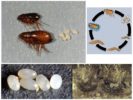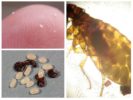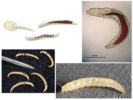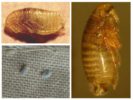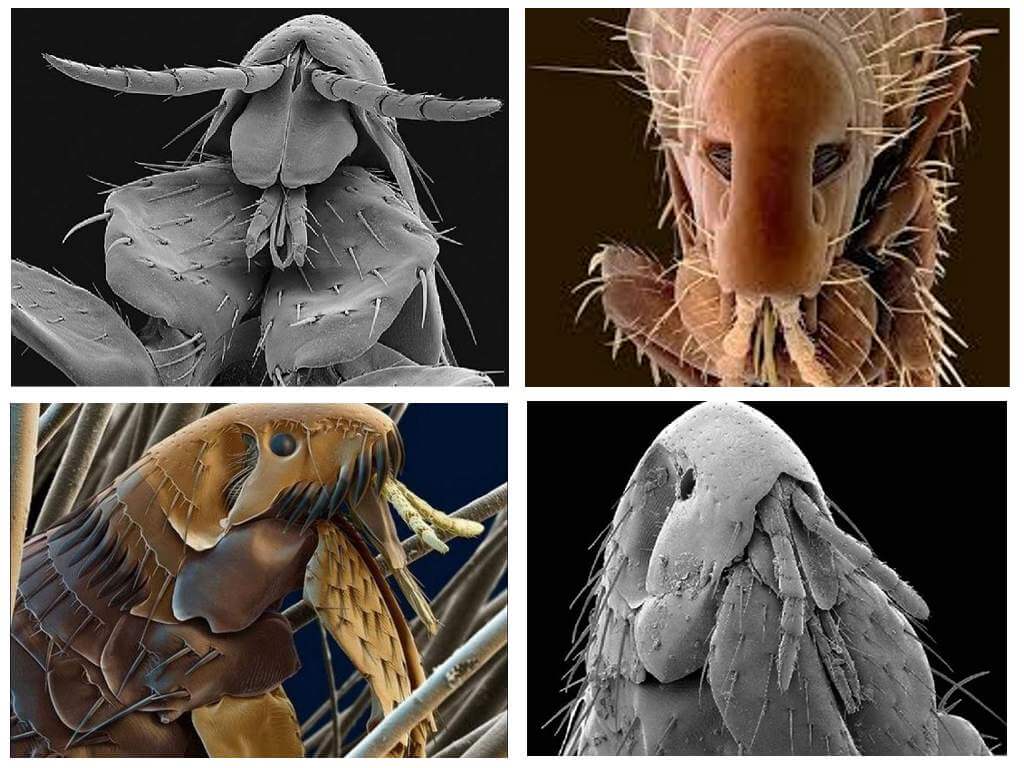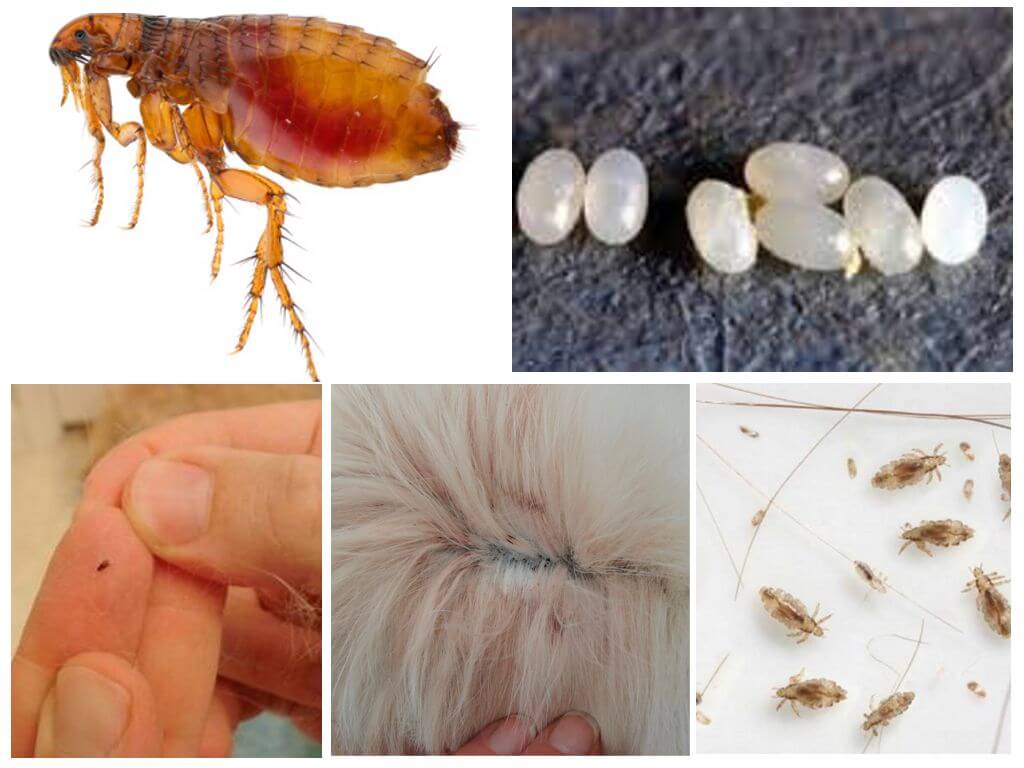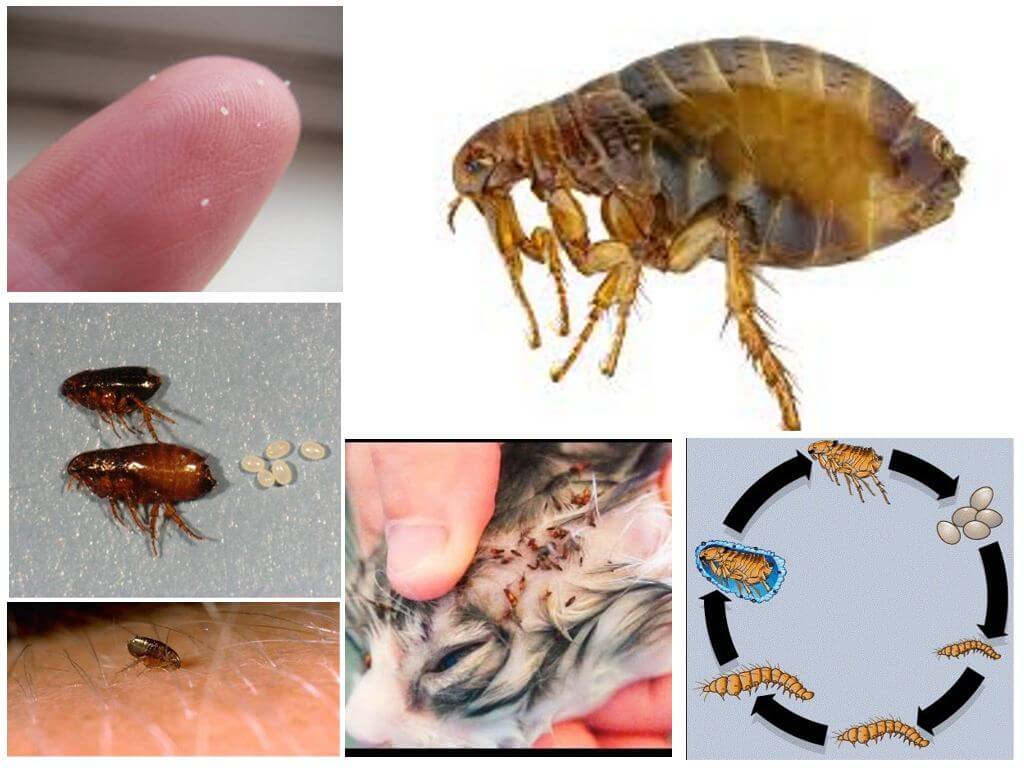- Flea developmental stages
- Flea eggs
- Flea larvae
- Dolly flea
- Flea Remedies
Our favorite pet cats and dogs are prone to appear on their bodies. fleathat are constantly breeding. Many are interested in what these parasites eat. Throughout their lives, they drink blood, which is their main food. The shape of adult insects is flattened, the body is characterized by shades of brown, their wings are absent. On the body there are a large number of bristles, spikes. They covered 3 pairs of limbs. Each of them performs certain functions.
Parasites easily and fairly quickly move through the coat, so the owner of the pet can not always see them. Due to their limbs, bloodsuckers not only move quickly, but they can jump, change direction and angle. Fleas dogs and cats - a common phenomenon, they multiply very quickly. If the animal lives in an apartment or house, then the fleas inseminate the existing premises. This is especially observed when the animal has a huge number of fleas. Before acquiring funds for their destruction, you need to understand how fleas breed. Will consider this issue in more detail.
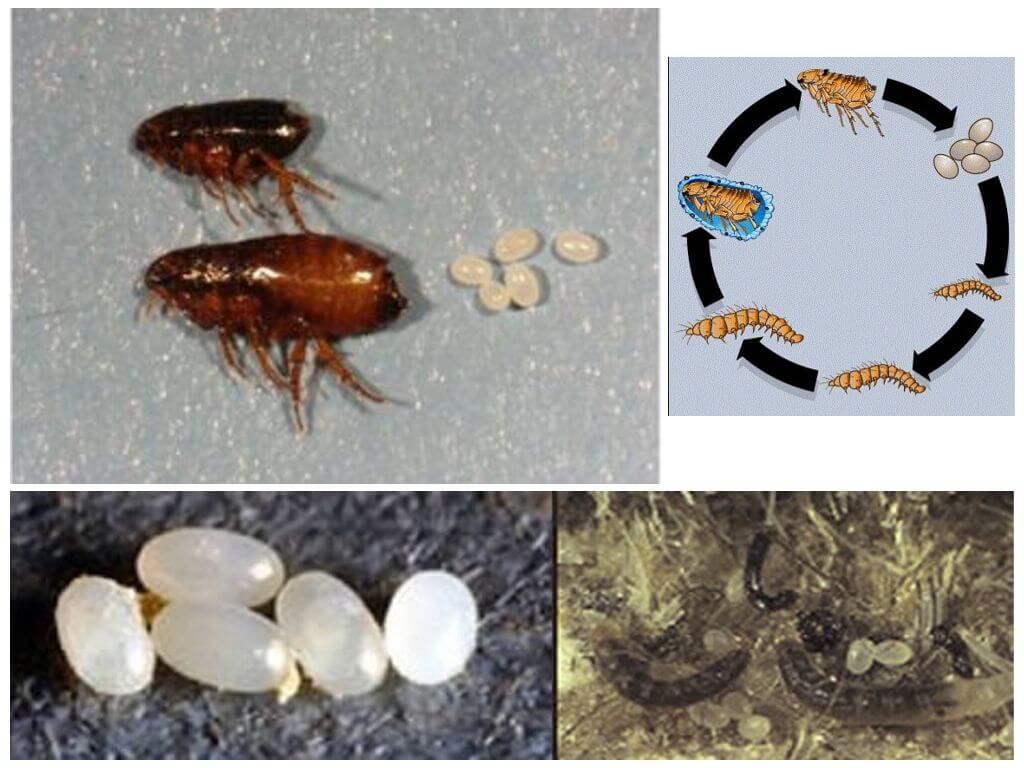
Life cycle and reproduction of fleas
Fleas breed under certain conditions. The male has testes ending in a sexual claw. The female has one or two pairs of ovaries, connecting at the uterus, and the sperm comes from her. In order for the process of moving seeds to the body of the female to begin, she has to climb onto the male and draw the sexual claw into her receptacle. Reproduction of fleas is a rather complicated process. It can last from one week to six months. It depends on how fleas breed in a given place.
On a note. In domestic animals, fleas breed at a temperature of 23 to 25 ° C, humidity of about 60%. At high temperature larvae and eggs just wither. If the air is cold and humid they die. The highest speed at which fleas breed when both of these indicators are high. In this case, the insects are large. A flea and a chrysalis can tolerate heat and cold.
Consider the stages of development of fleas in stages:
- The appearance of eggs;
- Larva;
- Pupae;
- Imago
The appearance of eggs
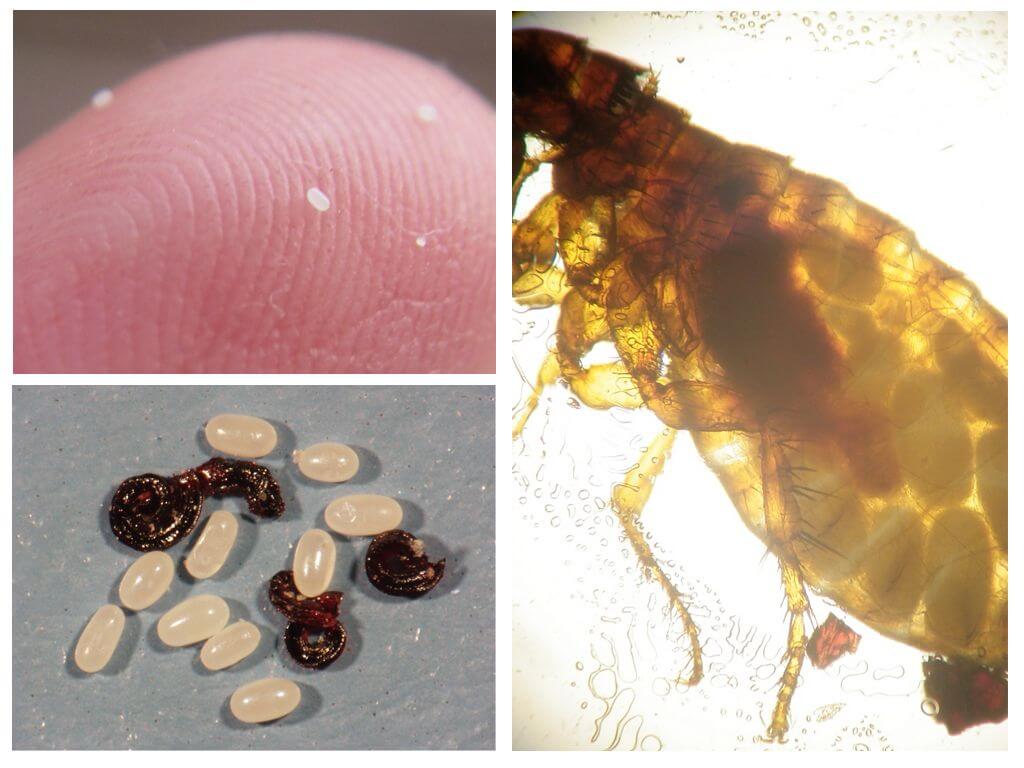
This is the first stage of the development of a flea, in which insects breed eggs. After the mating process, the insect is fertilized and is able to lay eggs. Their size is very small. When viewed through a magnifying glass, they resemble rice grains. If the population of parasites is very high, you can see how the eggs simply sprinkle from the hair of animals.
Flea eggs, due to their small size, can appear on the bed, in the villi of the carpet, in the genital gaps. Under such conditions, the breeding process is enhanced, the female can lay many eggs, and they are distributed in large numbers throughout the apartment. They can maintain their viability in an unfavorable environment for several weeks. In the body of an insect, eggs mature one at a time, on average, up to 15 pieces. This happens immediately after feeding. Moreover, this can happen anywhere, even in the hair of an animal. A flea simply shoots eggs so that they can fly apart. This allows them not to fight for food.
Larvae

In appearance, the flea larva resembles white worms, about 1 mm long. On their body there are thin hairs. Larvae are able to move quickly. They grow, and during the entire stage of their development they molt 3 times and reach a size of up to 6 mm. They can eat organic materials located next to them or on their body. Flea larvae in cats, dogs, and other animals, regardless of whom they parasitize, look the same. Therefore, if a person notices them, he will not be able to understand which insect they belong to. If you are interested in knowing how flea larvae look, you can see the photos available on the site. You should be aware that larvae do not live on the hair of cats and dogs. Therefore, if their owners found pests in the form of worms, these are not larvae.
On a note. Even the smallest larvae that have just been born have a tooth. It is a solid process by which this parasite breaks an egg. It disappears at its first molt.
If the larva's nutrition is normal, in sufficient quantity, after a couple of weeks each of them is sealed in a cocoon, from which a flea subsequently appears.
Dolls
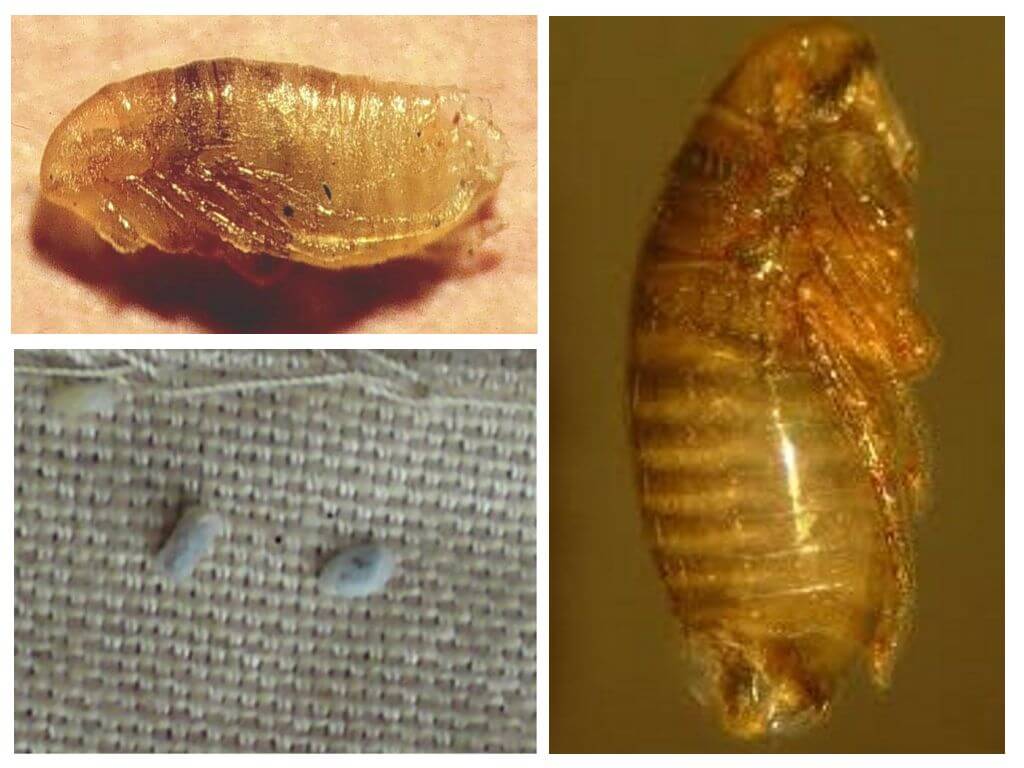
At this stage of reproduction, bloodsuckers have a very interesting life cycle. Pupa of fleas - this is the larva in a cocoon. Larvae can be in it for a different period of time, which depends on humidity and temperature. If they are an optimal parasite from the chrysalis, a week may appear. Otherwise, the flea pupae in the cocoon will be delayed for an indefinite period, which may be 12 months. The pupa evaluates the level of humidity and temperature with the help of receptors located on its outer cover. She also feels the carbon dioxide exhaled by a cat, dog or other animal. This cat or dog smell tells her special receptors. That is, the doll receives a signal saying that you can already leave the cocoon, since there is food nearby. According to scientists who have studied the life cycle of fleas, this is a real miracle of nature. How dolls can live in a cocoon for so long, what they eat is still unclear. Many are interested in how to kill a chrysalis. The fact is, not all chemical agents act on them, they are not able to penetrate the shell. It is impossible to create conditions in the apartment for very high and low temperatures. It remains only to wait for the time when the doll itself leaves the cocoon.
Imago
This breeding stage ends with a flea development cycle. As soon as the favorable moment arrives, the chrysalis emerges from the cocoon and searches for a master, catches up, jumps on it, finding a place in the animal’s thick coat.
People are interested in the question of how many eggs a flea lays during the breeding process. The period of her life ranges from a month and a half to two years. Therefore, each individual reproduces and multiplies in different ways. The maximum number of eggs that she can produce is about 500 pieces.
On a note! An adult without nutrition can live for several months. But her health will not be harmed. But due to the period of prolonged hunger strike, she will not be able to multiply and lay eggs.
How to get rid of eggs and larvae
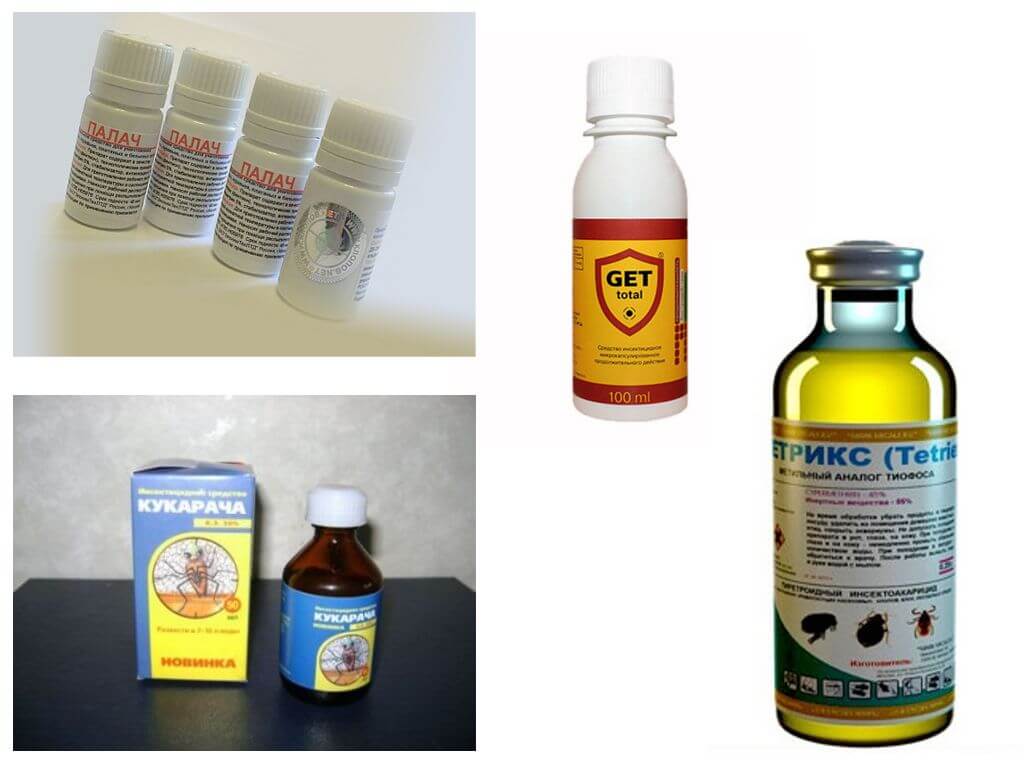
Experts believe that fleas for pets are not so dangerous. But this is only if there are not a huge number of them. Not only that, they claim that they are even useful for animals. In a population, these parasites jump around the apartment, causing people a lot of trouble. Having studied all the stages of development of insects, looking at the photo, how they can look, you can begin to fight them. In order to kill eggs and larvae, you can use the following tools:
- Cucaracha, Executioner, Tetrix. They can be used in the form of diluted preparations or concentrates. Aerosols Kombat and Raptor have also proven themselves well.
- Diana and Get.The basis of these drugs is a system of microcapsules that create a barrier on the treated surface. As soon as the flea comes into contact with it, nanocapsules adhere to the limbs and body of the insect, cocoon, eggs - their destruction begins.
- Raptor. It acts instantly and is characterized by a prolonged action.
- Raidhaving in its composition destructive and deterrent substances.
- Turpentine, vinegar, kerosene are folk remedies that can also help in some cases.
- You can destroy the larvae with Dichlorvos. But this drug is not as effective as modern facilities.
- Clean house. The components contained in it cause paralysis and cramps leading to death.
- Butox 50 - a drug that can destroy ticks, bedbugs, mosquitoes.
- Dusts that are completely useless against fleas can also kill larvae. Their action begins when the parasites eat, so the dust should be near them. This can not always be done, as pests can hide in hard-to-reach places.
Now it’s clear how fleas breed and how to deal with them.
